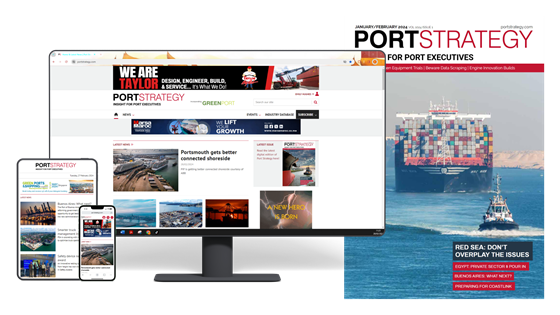Container & Cargo Handling – Page 70
-
News
Port Profile
China's Pearl River Delta has effortlessly lifted the crown for the most densely port-populated region in the world, as Wing Kah-goh reports
-
 News
NewsKalmar unveils new auto selfloader
To meet projected demand, Kalmar has launched Autoshuttle, an automated self-loading vehicle able to pick, place and transport containers between ship-to-shore (STS) and yard stacking cranes.
-
 News
NewsServicing future needs
Larger ships and increasing productivity mean that proper maintenance of terminal equipment is more important than ever, reports Patrik Wheater
-
News
Congestion sidebar
Making sure a terminal is able to run at its peak efficiency is the first thing port operators should strive for when seeking to eliminate congestion, according to the chief operating officer of the world''s largest container shipping company.
-
News
Congestion: Problem child or golden goose?
Is the port congestion plaguing our industry a problem child or golden goose, asks Stuart Pearcey
-
News
Congestion shorts
Iron Ore port Visakhapatnam in India has banned vessels that can''t manage to load at least 1,500tph from two of its jetties. Slower rates cause congestion, say Port Authorities.
-
News
Smaller solutions
Many small- and medium-sized ports are still using "home-made" terminal management systems and often there is resistance to adopting new technology, claims John Holm Jensen, consultant for Denmark''s WM-data.
-
 News
NewsFeeling familiar
Terminal operating systems all look and feel fairly similar, says Dave Quennell at Jade.
-
News
Seeing the process through
The introduction of berth scheduling software at Associated Petroleum Terminals (APT) in Immingham a few years ago was not without its difficulties. Bob Law, APT''s oil movements controller, saw the process through. "Many of my colleagues were understandably sceptical," he says. "We had managed berthing operations seemingly quite well until ...
-
 News
NewsChange brings higher return on investment
Changing a terminal management system can be a very daunting task for management and staff to consider, says Michael Schwank, president of Tideworks Technology.
-
 News
NewsMaking the jump
Too risky to stay with the old, or too risky to move to the new? Felicity Landon investigates the challenges of switching from one terminal management system to another
-
 News
NewsCoal: fuel for the future
A 180% increase in seabourne traded coal over two decades has spurred the world''s dry bulk ports into action, as Stuart Pearcey finds out
-
 News
Newssidebar for coal
Continuing increases in shipped coal volumes have led Italian company Coeclerici to think outside the box and create a means of expanding ports seawards rather than landwards.
-
 News
NewsGhanaian aims high
Privatisation of the Ghanaian ports of Tema and Takoradi has been ongoing since 2000 as part of a World Bank-supported modernisation programme. But while Oscar Cudjoe, public affairs manager for Ghana Ports & Habours Authority (GPHA), accepts that the introduction of new companies has been a success, he says that ...
-
 News
NewsDriven by efficiency
Ports can make significant fuel savings by selecting the right drive for their container handling operations, writes Patrik Wheater
-
News
GPA cranes off Good Hope
There can be no greater yardstick to measure the market acceptance of increasingly larger containership tonnage than the increase in container handling capacity, especially orders for new super post-panamax cranes.
-
News
Hybrid option offers green gain for ports
A hybrid option for ro-ro tractors will offer a green gain for ports, as David Foxwell finds out
-
News
Growing demand for secondhand
Although manufacturers such as MAFI concentrate on the market for newbuild ro-ro tractors, the company acknowledges that there is a growing demand for secondhand machines.
-
 News
Newstemporary storage feature 1
Sub-letting of temporary storage structures could prove and important revenue stream for wiley port operators. Stuart Pearcey explains
-
News
Testing the grade in Alaska
It took a decade of searching before an Alaskan ship repair company could find a suitable building to house some of its dry docking facilities - but once it did, erection took only a fortnight.











